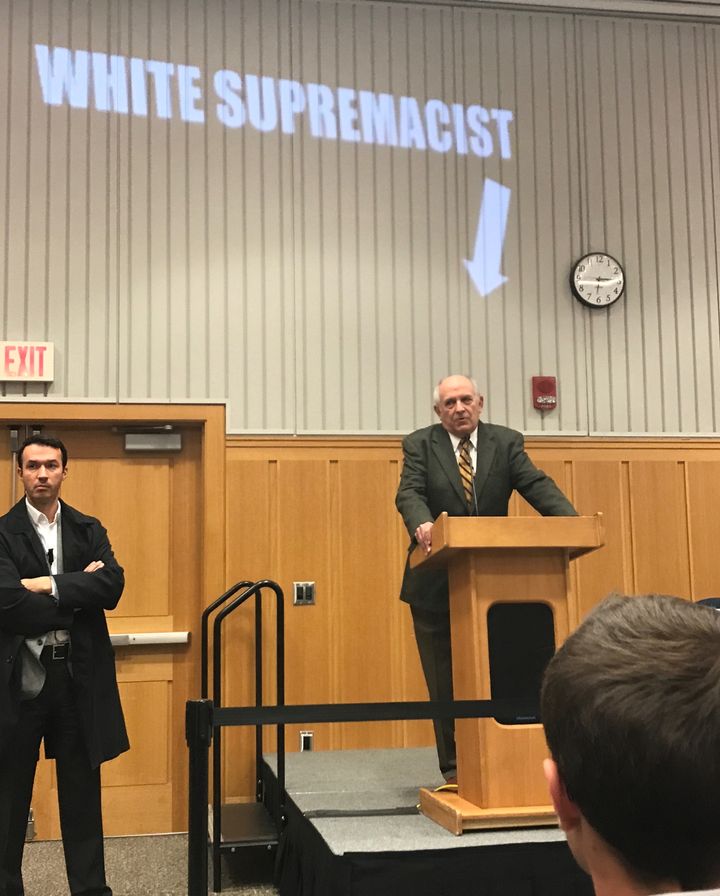This author of this piece is Michael Medina, a doctoral candidate at the University of Michigan. For the month of November, members of Students of Color of Rackham (SCOR) will present the creative work and organizing of graduate students at UMich as part of #NoNonsenseNovember - an organized response by graduate students of color at the University of Michigan against white supremacy and racialized violence.

Protestors project "White Supremacist" above Charles Murray during his speech at the University of Michigan.
Charles Murray had decades to earn a reputation as a white nationalist. We had one week to stop him.
It was just past 7:00pm when our graduate student group began discussing the final matter of the night: Charles Murray was coming to campus.
For decades, Students of Color of Rackham, a graduate student organization, has supported the well-being of University of Michigan students—particularly, students of color. This month, we had our work cut out for us. Racist flyers were hung across campus, racial slurs were written on students’ doors, and pro-Latinx messages were vandalized at a school monument.
These kinds of anonymous, hateful acts were nothing new, and are a constant reminder that racism is not an abstract idea from some long time past. It lives next door to us, sits next to us in class, and lies to us every day that we are not, and never could be, good enough. It takes a toll.
And it also it wastes our time. The average graduate student is expected to take classes, conduct research (often disproving the very racist claims we pass on the way to school), publish manuscripts, teach courses, present at national conferences, and continuously read the recent work in our field. This is often on top of raising a family, working to pay for our schooling, and, if we’re lucky, maintaining a life outside of academia. The workload of undergraduates is similarly taxing.
So what do we, as a community, do when racism comes to campus? We pull double-duty. We reframe the conversation around race on college campuses. We meet with administrators to discuss solutions and demand accountability. We thoroughly debunk the pseudoscientific claims.
And we protest. We make it clear that universities should be bastions of truth. Hate speech and false science deserve no platform here.
But this time we weren’t discussing some anonymous assailant. We knew exactly who was coming.
A white nationalist speaks
Dr. Charles Murray, outspoken political scientist, co-authored the now infamous “The Bell Curve” with Dr. Richard Herrnstein in 1994. The book helped mainstream the now scientifically defunct perspective that IQ is primarily determined by our genes, as well as spur claims that black and Latinx populations are inherently inferior to whites. These views, among others, earned him the label of white nationalist by the Southern Poverty Law Center.
We were surprised to learn, then, that Dr. Murray had been invited to speak on October 12th by the American Enterprise Institute and the university’s branch of College Republicans. That was five days away, and there was work to be done.
Five days before the event
We draft a letter to College Republicans requesting Dr. Murray’s invitation be revoked for three reasons:
First, his incendiary presence on campus will add to an already simmering racial climate at Michigan. The announcement of the event alone was followed by more discrimination on campus, seemingly drawn from Dr. Murray’s own work.
Second, in the years since its publication, many of the IQ-related claims in “The Bell Curve” have been refuted, some even by University of Michigan researchers.
Third, their welcoming of Dr. Murray undermines College Republican’s own highly public call for campus unity in the face of racial tensions.
Despite this olive branch, we also cover our bases: we reach out to other multicultural organizations on campus and spread the word.
Four days before the event
We review Dr. Murray’s past college appearances. His recent speech at Middlebury College was completely shut down by protesters, and one faculty member was injured in the process.
Safety becomes a constant topic of discussion.
Three days before the event
The Multicultural Leadership Council, a coalition of over one dozen equity-based graduate student organizations, signs our letter requesting that Dr. Murray’s invitation be rescinded. Additional organizations are contacted and collaborations are arranged. The rest of the day is spent catching up on grading.
Two days before the event
At 12:25pm, the letter is sent to College Republicans. At 7:25pm, we receive our reply.
They thank us for voicing our concerns and assure us they do not agree with all of Dr. Murray’s views. They do, however, support his freedom of speech and right to have a “respectful dialog” on campus. The event will go on.
On to Plan B. Protest flyers are made and distributed throughout the school. Social media (the protester’s godsend) draws in students and faculty wanting to get involved but not sure how. Members of our executive board stay late on campus, making signs and creating a protest timeline. Homework is put off for another night.
One day before the event
We are contacted by the University of Michigan’s Division of Public Safety and Security. Word of our protest has spread and the legal ramifications loom large. This may be due, in part, to us not having publicized our plans. The threat of counter-protests is ever-present and we must balance keeping students informed and keeping the protest viable until the last possible moment.
Final arrangements are made and one last round of advertising is sent, this time with a wider net.
Friends and family are contacted. “Going to a protest tomorrow. I’ll be safe. I love you.”
The day of the event
Much of the day is a blur. Classes are a mix of half-hearted engagement and frantic email checking. Has the event been cancelled? Do we have enough supplies? Is everyone safe?
When the last school responsibility is finished (or rescheduled, or skipped), we rush over to the agreed upon meeting spot. The speech begins at 6pm. Our flyer said to meet at 4:30pm for prep. The first students arrive at 4:32pm.
The crowd is overwhelming. Over 200 arrive within minutes, many already holding signs, megaphones, and umbrellas (it was, of course, raining). A number of other diversity organizations coalesce at our location: Students4Justice, Campus Antifascist Network, By Any Means Necessary. We welcome them all and make it clear that, while we may have different protesting methods, we share a common purpose and the time to act is now.
Our group’s method of choice? A silent work-in. Students were instructed to bring headphones, books, and laptops to the speech and, when it begins, turn it into our personal study lounge.
This plan turned out about as well as Dr. Murray’s. From the moment he stepped on stage until the moment the protesters left, as planned, en masse, there was never silence. Protesters (who occupied roughly 170 of the room’s 200 seats) debating and challenged him, called out the names of authors who had refuted his work, and read testimonials about the deleterious impact of his work on their lives. Graduate student Bryan Ransom joined Dr. Murray on the stage, pointing out the gaps in the speaker’s analyses and reasoning. The audience collectively guffawed at Dr. Murray’s attempts to explain he could not be a white supremacist because he has “mixed race children.”
Many of us wound up getting very little work done, but Dr. Murray accomplished even less, and that was the point.
The aftermath
The first article about the protest released a few hours after its end, and a dozen more by the next day. Most remained neutral, though the anti-protest leanings of others ranged from subtle to overt. The arguments have become predictable:
“Protests infringe upon free speech; you are undermining the intent of a university; if you disagree with his ideas, debate them.”
The responses have also become memorized:
“Protests are also free speech; universities are meant to produce knowledge, not pseudoscience; those ideas were debunked years ago.”
What is not often mentioned, though, is that protests reaffirm the humanity of the oppressed. Protests don’t need to be popular – the very fact that we need them ensures they will not be. They also don’t need to be groundbreaking – Dr. Murray went on to continue speaking to a small group once we left. They just need to happen, and happen regularly, as a reminder that inequity, untruth, and injustice well never be met without a fight.
For many, this protest may have just been a headline. For us, it was one long week in a lifetime pursuit of social justice.
And it won’t be the last.
Michael Medina is a doctoral candidate at the University of Michigan.
